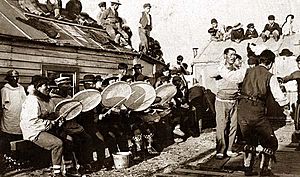Inuit music facts for kids
Traditional Inuit music is the music of the Inuit, Yupik, and Iñupiat peoples. For a very long time, their music has used drums for dancing. A special way of singing called katajjaq (Inuit throat singing) has also become very famous in Canada and around the world.
Inuit music often sounds like talking or chanting. It has complex rhythms and usually uses a small range of notes. You'll often hear major thirds and minor seconds in the melodies, which move in a wavy way.
The Copper Inuit, who live near the Coppermine River, have two main types of music. A song is called pisik (or pisiit or piheq) if the person performing also plays drums. If they only dance, it's called aton. Each pisik is a personal song for a drummer. It includes dancing and singing. Every drummer has their own style and performs at gatherings. They use one drum, and the performance often starts slowly, then gets more exciting. The wooden frame drum, called a qilaut, is played on its edge with a wooden stick called a qatuk. The performer tilts the drum and dances to the beat.
Contents
Music's Role in Inuit Culture
Long ago, the Inuit languages didn't have a word exactly like our word "music." The closest word, nipi, meant sounds in general, including speech and noise. Traditional Inuit songs were often heard as parts of a bigger experience, not just as standalone "music."
Before people could record music, Inuit music was often used in spiritual ceremonies. People would ask spirits for good luck when hunting or gambling. There were also simple lullabies to help babies sleep. Interestingly, traditional Inuit music didn't usually have songs about work or love.
Things started to change when European whalers arrived in the 16th and 17th centuries. They brought instruments like the accordion. Dances like the jig and reel became popular. In the 20th century, American country music, especially from Scottish-Irish traditions, became very popular among the Inuit.
Katajjaq: Inuit Throat Singing
Katajjaq (also called pirkusirtuk or nipaquhiit) is a special type of traditional song. It's often seen as a game, usually played by two women. It's one of the few examples of overtone singing in the world. This is a unique way of making sounds, also known in places like Tuva.
When playing, two women stand close, face-to-face. They sing using a complex method where one voice hits a strong beat while the other hits a weak one. This makes their two voices blend into almost one sound. They repeat short musical ideas, often copying sounds from nature. These can be sounds of geese, caribou, or other animals. The game continues until one person runs out of breath, gets tongue-tied, or starts laughing. Then the game is over. Older women who teach children this singing will correct mistakes in how the sounds are made, how the phrases fit together, and the rhythm.
Inuit vocal games are usually played by two women facing each other very closely. They use the other person's mouth as a way to make the sounds louder. Sometimes they even play under a kitchen pot to make the sounds echo more. The game involves repeating words that don't mean anything in a tight, rhythmic way. The strong beat of one singer matches the weak beat of the other. This also means their breathing is opposite. They use different ways of making sounds, like voiced (with sound) and voiceless (just air) sounds. They also place the sound in different parts of the body, like the chest, throat, and nose. These vocal games are very special to the Inuit people.
Western Music's Influence
When European explorers came in the 16th and 17th centuries, they brought their music. This changed Inuit music. The very detailed and complex rhythms of traditional Inuit music started to become more like Western music.
Today, many Inuit musicians mix traditional Inuit music with popular styles. They might combine it with rock, pop, or country music.
Musical Instruments
Percussion Instruments

- The main percussion instrument is the wooden frame drum called the qilaut. It's made by boiling and bending strips of wood into a circle, with a handle sticking out. Animal skin, usually caribou, is stretched tightly across the frame and tied down with string. These drums can be as big as one meter across, but are usually smaller. It's hit on the edge of the rim with a qatuk, which is a wooden stick. The sound is a mix of the drum being hit and the skin vibrating. Some groups, like the Inuvialuit near the Mackenzie River, use thin wands instead of thick wooden sticks to beat the drums.
- Other percussion instruments include smaller drums and rattles.
- The Jew's harp was also brought to the Inuit. Some groups, like the Inuit in Eskimo Point (now Arviat), Canada, play it.
String Instruments
- The tautirut is an Inuit bowed zither. It's similar to the fiðla or Icelandic fiddle. It's not clear if this instrument was invented by the Inuit or if Nordic sailors brought it. Inuit culture is one of the few cultures in the Americas that had string instruments before Europeans arrived.
- The kelutviaq is a one-string fiddle or lute. It's played by the Yup'ik people of Nelson Island and southwest Alaska.
Sharing Inuit Music
The Canadian Broadcasting Corporation (CBC) has been playing music in Inuit communities since 1961. That's when CFFB opened in Frobisher Bay (now Iqaluit, Nunavut). The CBC Northern Service was very important for sharing and promoting Inuit music. It was often the only way for musicians in the Arctic to record their songs or albums.
In 2016, a band from Nunavut called The Jerry Cans started Aakuluk Music. This was the first independent record label based in Nunavut.
Famous Inuit Performers
See also

